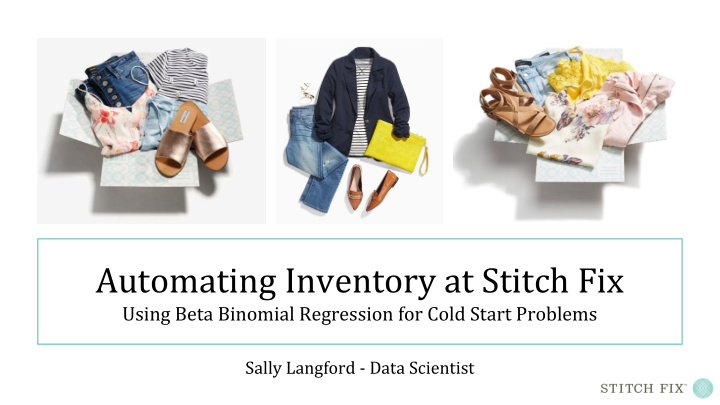



Automating Inventory at Stitch Fix Using Beta Binomial Regression for Cold Start Problems Sally Langford - Data Scientist
How Stitch Fix works:
How Stitch Fix works: - Tell us about your style, fit and price preferences.
How Stitch Fix works: - Tell us about your style, fit and price preferences. - A personal stylist will curate five pieces for you.
How Stitch Fix works: - Tell us about your style, fit and price preferences. - A personal stylist will curate five pieces for you. - Try all the items on at home.
How Stitch Fix works: - Tell us about your style, fit and price preferences. - A personal stylist will curate five pieces for you. - Try all the items on at home. - Give your stylist feedback on all items, then only pay for what you keep.
How Stitch Fix works: - Tell us about your style, fit and price preferences. - A personal stylist will curate five pieces for you. - Try all the items on at home. - Give your stylist feedback on all items, then only pay for what you keep. - Return the other items in envelope provided.
Benefits of Machine Learning in Inventory Management: - Scalable with business. - Rapid reforecasting. - Capture nonlinear relationships. - Cold start problems.
number of units shirt is sent to clients and is sold plaid shirt time order arrives in warehouse
number of units shirt is sent to clients and is sold plaid shirt time order arrives in warehouse
Inventory consumption of a style is proportional to; - daily demand, - clients for which the style is recommended, - whether there are units in the warehouse, - probability a stylist chooses to send the client this style, - if the client buys the style.
Inventory consumption of a style is proportional to; - daily demand, - clients for which the style is recommended, - whether there are units in the warehouse, - probability a stylist chooses to send the client this style, - if the client buys the style.
Inventory consumption of a style is proportional to; - daily demand, - clients for which the style is recommended, - whether there are units in the warehouse, - probability a stylist chooses to send the client this style, - if the client buys the style.
Ranked styles recommended for client - which will the stylist choose to send?
Ranked styles recommended for client - which will the stylist choose to send?
Ranked styles recommended for client - which will the stylist choose to send?
Ranked styles recommended for client - which will the stylist choose to send?
Ranked styles recommended for client - which will the stylist choose to send?
plaid long-sleeve shirt
? plaid long-sleeve shirt
plaid long-sleeve shirt
plaid long-sleeve shirt
... plaid long-sleeve shirt
... plaid long-sleeve shirt P(chosen) + P(not chosen) = 1
... plaid long-sleeve shirt ? blue long-sleeve shirt
Prior Beliefs
Evidence Prior Beliefs
Posterior Beliefs Evidence Prior Beliefs
N ~ Binom(N av , p)
N ~ Binom(N av , p)
N ~ Binom(N av , p) p ~ B( α , β )
B( α ’, β ’) = B( α 0 + k, β 0 + n - k)
B( α ’, β ’) = B( α 0 + k, β 0 + n - k)
Step 1: Use maximum likelihood to calculate α 0 and β 0 for the distribution of p in groups of similar styles. Step 2: After a period of time, update this prior for the number of times the new style has been recommended for a client ( n ), and chosen to be sent ( k ). Step 3: Calculate the mean and confidence interval of p from the resulting distribution. This is used as the probability that the new style will be chosen to be sent to a client. Step 4: Repeat steps 2-3.
VGAM (in python): import rpy2.robjects as robjects robjects.r.library("VGAM") robjects.r("fit = vglm(cbind(successData,trialData - successData) ~ 1, betabinomialff, trace=TRUE)") alpha, beta = robjects.r("Coef(fit)") import scipy fit = scipy.stats.beta.fit(data, floc=0, fscale=1) alpha, beta = fit[0], fit[1] --- result = scipy.optimize.minimize(loss_function, p0, jac=True, **kwargs)
Job Scheduler Data Scientist Code Flotilla: Auto scaling cluster SQL Engine Job server for Spark cluster Data Storage Hive Metastore SQL Engine
Top 5 recommendations for client A Top 5 recommendations for client B Top 5 recommendations for client C Top 5 recommendations for client D Top 5 recommendations for client E
B( α , β ) = B( μ / σ , (1 - μ )/ σ ) μ σ
μ = μ 0 + μ n log(1 + n)
number of units planned orders now time new styles
number of units forecasted units planned orders now time new styles
How do we use our inventory forecast model? - When should we re-order inventory? - How should we buy inventory by size? - How should orders be separated into different warehouses? - When should a style not be sent out anymore, in place of a new option?
Metrics of success: - Fraction of inventory out with clients compared to in the warehouse? - How many styles are available to send to a client? ∆ in the beginning of month projected units. - - Cumulative units sold over time.
Do you want to calculate the probability of success in a binomial process? Not enough data? Use Beta Binomial Regression for your cold start problem!
slangford@stitchfix.com Stitch Fix Algorithms Blog Algorithms Tour @stitchfix_algo
Recommend
More recommend